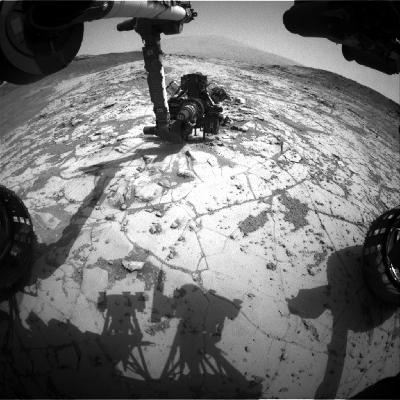Mon, Jan 19, 2015
Feature May Be Remnants Of A Salt Water Lake
A rock target where NASA's Curiosity Mars rover is using its sample-collection drill this week may have a salty story to tell.

This target, called "Mojave," displays copious slender features, slightly smaller than grains of rice, that appear to be mineral crystals. A chance to learn their composition prompted the Curiosity science team to choose Mojave as the next rock-drilling target for the 29-month-old mission investigating Mars' Gale Crater. The features might be a salt mineral left behind when lake water evaporated.
This week, Curiosity is beginning a "mini-drill" test to assess the rock's suitability for deeper drilling, which collects a sample for onboard laboratory analysis.
A weeklong pause in science operations to install a new version of rover flight software is scheduled to begin early next week, possibly before completion of the drilling and sample delivery. This is the fourth new version of the onboard software since the rover's August 2012 landing.
The Mojave drilling begins Curiosity's third round of investigating the basal layer of Mount Sharp exposed at an area called "Pahrump Hills." In the first round, the rover drove about 360 feet and scouted sites ranging about 30 feet in elevation. Then it followed a similar path, investigating selected sites in more detail. That second pass included inspection of Mojave in November 2014 with the dust-removal brush, close-up camera and Alpha Particle X-Ray Spectrometer on the rover's arm. The results put Mojave at the head of the list of targets for the rover's most intensive inspection, using laboratory instruments that ingest powdered rock collected by the drill.
"The crystal shapes are apparent in the earlier images of Mojave, but we don't know what they represent," said Curiosity Project Scientist Ashwin Vasavada at NASA's Jet Propulsion Laboratory, Pasadena, California. "We're hoping that mineral identifications we get from the rover's laboratory will shed more light than we got from just the images and bulk chemistry."
Curiosity's Chemistry and Mineralogy instrument, or CheMin, can identify specific minerals in rock powder from a drilled sample. Analysis of the drill hole and drill tailings may also reveal whether the crystals are only at the surface, like a salty crust, or are also deeper in the rock.
"There could be a fairly involved story here," Vasavada said. "Are they salt crystals left from a drying lake? Or are they more pervasive through the rock, formed by fluids moving through the rock? In either case, a later fluid may have removed or replaced the original minerals with something else."
Curiosity's work at Pahrump Hills may include drilling one or more additional rocks before heading to higher layers of Mount Sharp.
Next week's planned software revision, like the mission's earlier ones, adds protections against vulnerabilities identified in rover testbed activities on Earth. It also adds improvements to make planning drives more efficient.
"The files have already been uplinked and are sitting in the rover's file system to be ready for the installation," said JPL's Danny Lam, the deputy engineering operations chief leading the upgrade process.
One change in the new software is to enable use of the rover's gyroscope-containing "inertial measurement unit" at the same time as the rover's drill, for better capability to sense slippage of the rover during a drilling operation. Another is a set of improvements to the rover's ability to autonously identify and drive in good terrain.
(Image provided by NASA)
More News
“These new aircraft strengthen our ability to respond quickly, train effectively and support communities nationwide. Textron Aviation has been a steadfast supporter in helpin>[...]
From 2011 (YouTube Edition): Rugged, Legendary, STOL Twin Makes A Comeback The de Havilland Twin Otter is an airplane with a long history, and it gained a reputation as a workhorse>[...]
A Wind Gust Lifted The Right Wing And The Airplane Turned To The Left Analysis: The pilot was departing from a 2,395-ft-long by 50-ft-wide turf runway. The pilot reported that afte>[...]
Have A Story That NEEDS To Be Featured On Aero-News? Here’s How To Submit A Story To Our Team Some of the greatest new stories ANN has ever covered have been submitted by our>[...]
Braking Action Advisories When tower controllers receive runway braking action reports which include the terms “medium," “poor," or “nil," or whenever weather con>[...]
 Aero-News: Quote of the Day (12.18.25)
Aero-News: Quote of the Day (12.18.25) Classic Aero-TV: Viking Twin Otter 400--Bringing the DHC-6 Back Into Production
Classic Aero-TV: Viking Twin Otter 400--Bringing the DHC-6 Back Into Production NTSB Final Report: Rans Employee Flying Club Rans S-6ES Coyote II
NTSB Final Report: Rans Employee Flying Club Rans S-6ES Coyote II ANN FAQ: Submit a News Story!
ANN FAQ: Submit a News Story! ANN's Daily Aero-Term (12.18.25): Braking Action Advisories
ANN's Daily Aero-Term (12.18.25): Braking Action Advisories



